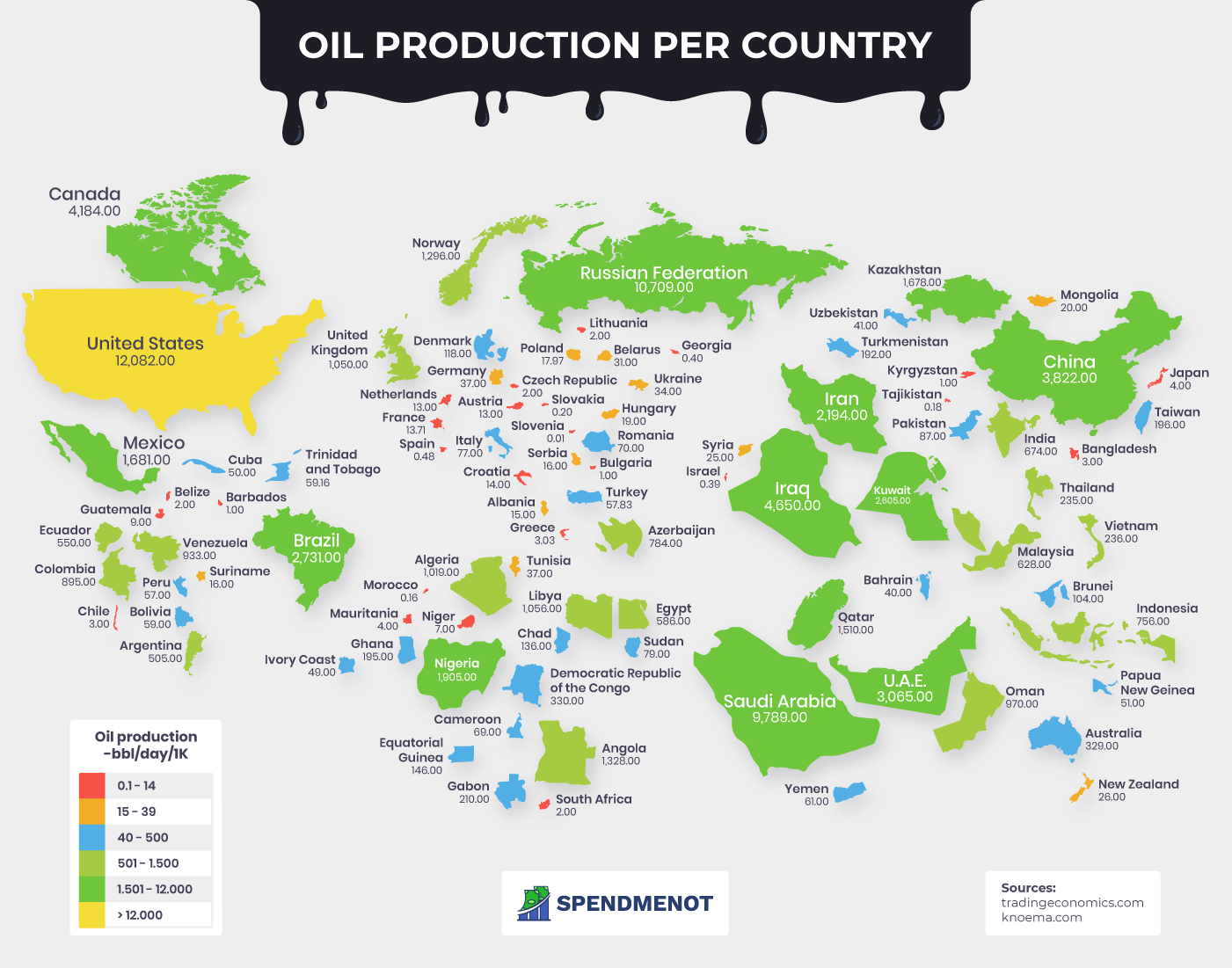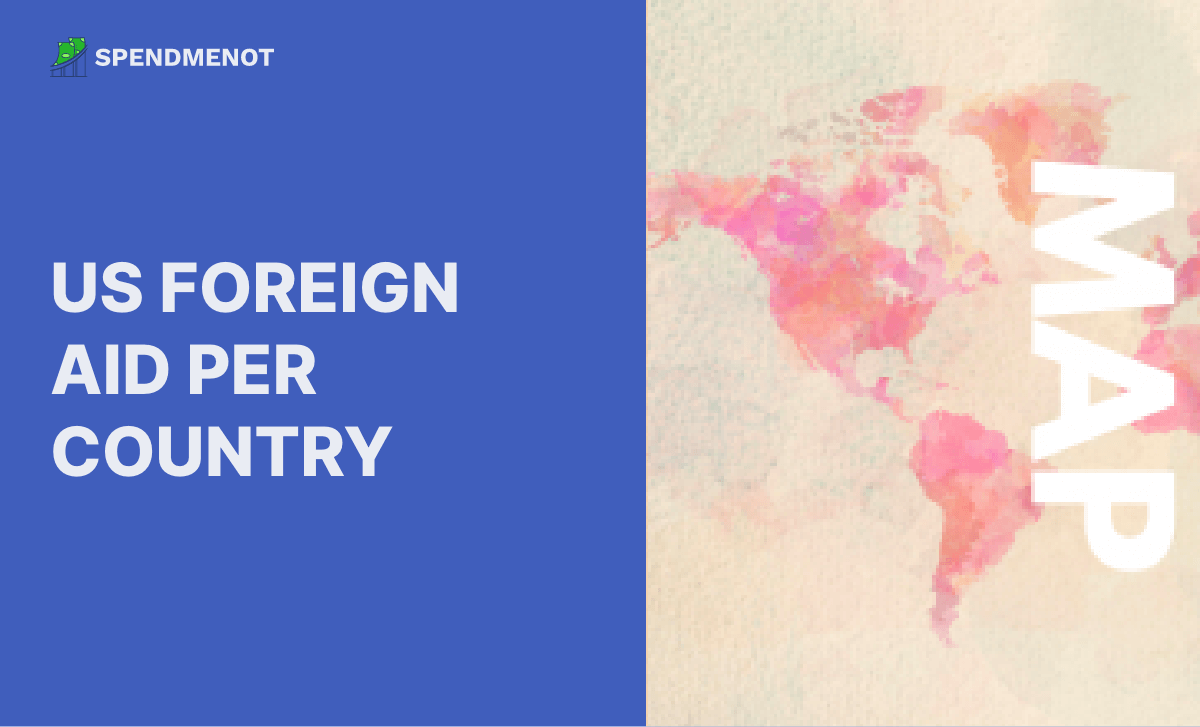Oil Production by Country: The Top Players
Last Updated: June 15, 2021
Who are the world’s leaders in oil production?
Over a third of the total energy we consume is derived from oil.
Our map of oil production by country is an eye-opener!
This Map Shows Oil Production by Country
Which country produces the most oil?
Here is the global oil production laid out on a map. The numbers represent oil production in thousands of barrels per day (bbl/day/1K).
This is why countries that control the world’s oil reserves usually have economic power, and it’s why we’ll deal with oil production by country in this article.
Now:
Crude oil is an unrefined petroleum product that is found naturally around the world. This product is so precious that it’s commonly referred to as black gold. Gasoline, diesel, industrial lubricants, asphalt, ethane, and propane are just some of the products that the world runs on that are derived from crude oil.
Below, you’ll find or list of the 20 largest oil and gas exploration and production countries on the planet. Read on.
Oil Production by Country: The 10 Biggest Oil Producers
When it comes to oil, these countries have the upper hand.
1. In August 2019, the production of crude oil in the US was at 12.37 million barrels per day.
(Source: Knoema)
The United States is the number one country in terms of production, supply, and consumption of energy. The country’s energy companies produce oil, natural gas, coal, renewable fuels, and electricity from clean energy sources, including wind, solar, hydropower, geothermal, and nuclear power.
Most of the companies are independent producers, and they commonly produce solely in the United States. There are, of course, oil companies that have thousands of employees and operate globally. The two most well-known US oil companies are Chevron and ExxonMobil.
The United States oil production is nearly matched by the petroleum import figures:
In 2018, the US was importing a massive 9.94 million barrels per day. Most of the petroleum imported by the US is crude oil (70-80%). Oil production generates 14% of the US total economic output.
2. In August 2019, the production of crude oil in the Russian Federation was at 10.77 million barrels per day.
(Source: Knoema)
Russia is the number two country when it comes to world crude oil production and the second-largest maker of dry natural gas. Russia also produces an important amount of coal. Most of the country’s reserves are in Western Siberia, between the Ural Mountains and the Central Siberian Plateau, as well as in the Volga-Urals region, reaching out into the Caspian Sea.
Russia’s oil and natural gas industry is a key factor in the country’s economy, with revenues from oil and natural gas activities and exports accounting for 36% of Russia’s federal budget revenues.
3. In August 2019, the production of crude oil in Saudi Arabia was at 9.78 million barrels per day.
(Source: Knoema)
The top three largest oil producers part of this text ends with Saudi Arabia, the first OPEC member on the list. With 267 million barrels in oil reserves, this is the second-largest oil reserves country in the world, after Venezuela.
Heavily reliant on its oil production, Saudi Arabia derived over 75% of its $170 billion in export revenue from petroleum.
What’s more:
Saudi Arabia is also developing its increasing energy sources of natural gas As a result, the country has developed into a producer of refined oil products and petrochemicals such as kerosene, diesel oil, and gasoline.
4. In August 2019, the production of crude oil in Iraq was at 4.65 million barrels per day.
(Source: Knoema)
Iraq is one of the world’s most influential oil producers and has rightfully taken a spot among the top countries by oil production in the world. Over the previous years, Iraq’s energy production and revenue have suffered due to the war in the country and the wider region.
The thing is:
As an oil country, Iraq heavily depends on oil revenue, more so than the rest of its OPEC partners. Oil, natural gas, and other petroleum-related products were responsible for bringing 95% of Iraq’s $60.8 billion in exports last year.
In the last half-decade, average daily oil production in the country climbed from 2,783 thousand barrels to 4,830 thousand barrels per day in December 2016. It then dropped slightly in 2019.
5. In August 2019, the production of crude oil in China was at 3.82 million barrels per day.
(Source: Knoema)
When it comes to world energy consumption, China, the most populous country in the world, relies more on oil than any other country other than the United States. China burned around 608 million tons of oil in 2017.
And that’s not all:
Natural gas use in China has further expanded over the previous years, and the country has pursued to strengthen natural gas imports via pipeline and as liquefied natural gas. China is the world’s top coal producer, consumer, and importer.
China also imports oil. Petroleum imports from Saudi Arabia, Iran, Iraq, and other Middle Eastern countries represented over 10% of China’s $1.5 trillion in imports in 2017.
6. In August 2019, the production of crude oil in Canada was at 3.62 million barrels per day.
(Source: Knoema)
As one of the top oil producing countries, Canada heavily depends on this precious source. The country’s oil and natural gas production accounts for 7% of the gross national product. It employs half a million people, mostly in the three prairie provinces of Manitoba, Alberta, and Saskatchewan.
Back in 2014, almost 3 million barrels of crude oil were being exported, with 97% of the total amount going to the US. During the same year, Canada was responsible for 5% of the total world oil production.
7. In August 2019, the production of crude oil in Nigeria was at 2.03 million barrels per day.
(Source: Knoema)
Nigeria is the most populous country within the OPEC, but in terms of current oil production, it positioned eighth within the group.
In addition to petroleum, Nigeria also possesses and exploits sources of natural gas, iron ore, coal, limestone, niobium, lead, zinc, and arable soil.
This is huge:
Nigeria heavily depends on oil, which accounts for about 90% of export income and over 70% of the total government revenues, similar to the other members of the biggest oil producers in the world club.
8. In June 2019, the production of crude oil in Mexico was at 1.68 million barrels per day.
(Source: Knoema)
Producing almost 1.7 million barrels of crude oil per day, Mexico earned a spot on our list, as well as the right to be called one of the largest producers of petroleum in the world.
Mexico is also the third-largest oil producer in the Americas after the United States and Canada, global oil production data shows.
It is also a vital ally in the US energy trade:
Back in 2015, 9%, of the US crude oil imports came from Mexico.
The oil industry generated just 6% of the country’s export earnings during the same year, while in 2009, oil accounted for 30% of Mexico’s exports.
9. In August 2019, the production of crude oil in Norway was at 1.37 million barrels per day.
(Source: Knoema)
Producing around 2% of the global oil demand, Norway is one of the largest oil producing countries in the world. The total export value of crude oil and natural gas in 2015 was around $450 billion, or approximately 40% of the total exports for the year.
Check this out:
About a third of the EU’s natural gas imports come from Norway. Norwegian natural gas can play an important role in the transition to a low-carbon economy, which could make oil and gas the most important export commodities in the Norwegian economy in years to come.
10. In August 2019, the production of crude oil in Angola was at 1.32 million barrels per day.
(Source: Knoema)
The Republic of Angola is the second top oil producer in Africa and an OPEC member.
Approximately 75% of the oil production in Angola comes from offshore fields. According to expert sources, Angola produces light sweet crude oil with low amounts of sulfur, which is suitable for the production of light refined petroleum products.
Although the country is the leading oil producer in the region, it imports 80% of its demand for refined petroleum products, including gasoline, diesel, aviation fuel, and oil fuel. Crude oil accounts for $26.8 billion of the country’s $30.3 billion worth of exports, oil production by states numbers point out.
10 More Major Oil Producers
11. In August 2019, the production of crude oil in Venezuela was at 0.93 million barrels per day.
(Source: Knoema)
Venezuela is a member of the OPEC group and the 11th biggest oil producer in the world. Apart from petroleum, the country’s natural resources include natural gas, iron ore, gold, bauxite, diamonds, and other minerals.
Astonishingly, Venezuela’s oil revenues account for about 99% of export profits, supplies about half of the essential government income, and is responsible for about one-third of the country’s gross national product, world oil production data uncovers.
12. In August 2019, the production of crude oil in the United Kingdom was at 0.86 million barrels per day.
(Source: Knoema)
The United Kingdom is lavishly endowed with energy resources. The country started exploiting the sources of oil and natural gas located in the North Sea off of Orkney and Shetland during the 1960s, speeding up its economic growth exponentially.
The average monthly crude oil exports for the UK were at just under $900 million per month for the period from 1970 to 2019, world crude oil production historical data shows. Currently, this island nation exports around $2 billion worth of crude oil per month, while its total exports are worth around $72 billion per month.
13. In August 2019, the production of crude oil in Azerbaijan was at 0.67 million barrels per day.
(Source: Knoema)
Located in one of the major Caspian Sea export routes, Azerbaijan is making a great effort to exploit its strategic position and oil reserves. Even though the country has been known as one of the oldest oil producers in the world, its significance as a gas producer and exporter is also flourishing.
Exports and oil and gas production are insanely significant to Azerbaijan’s economy:
According to the latest oil production by country data, oil and gas exports make more than 90% of the country’s exports.
14. In August 2019, the production of crude oil in India was at 0.65 million barrels per day.
(Source: Knoema)
The oil and gas segment is one of the most significant industries in India and plays a vital part in affecting decision-making for all the other essential parts of the economy, IBEF states.
Around 70% of India’s domestic production of crude oil and natural gas is done by a single company, Maharatna OGNC.
In 2018, India exported about $48.3 billion worth of petroleum products, which makes it one of the top petroleum producing countries in the world. Overall, 15% of India’s exports are related to fuel.
15. In August 2019, the production of crude oil in Indonesia was at 0.65 million barrels per day.
(Source: Knoema)
During August, Indonesia was producing just 64,000 barrels less than India per day, on average. In addition, this country also produces coal, tin, and natural gas.
Interesting fact:
The discovery of oil in the North Sumatra region of what was then called the Dutch East Indies in 1883 was what led to the formation of Royal Dutch Shell in 1890.
Once one of the world’s largest oil producers, Indonesia started importing more than it produces in 2004. The country used to be an OPEC member, but it left the group in 2008.
In December of 2018, oil and gas imports more than doubled the exports, being worth $3 billion and $1.3 billion respectively. Indonesia’s oil and gas industry provides 20% of the country’s revenue and around 280,000 jobs.
16. In August 2019, the production of crude oil in Egypt was at 0.61 million barrels per day.
(Source: Knoema)
Egypt is one of Africa’s top oil producing countries and the largest non-OPEC producer of oil on the continent. With oil and gas representing one of the most prominent industries in the state, hydrocarbon production represents the most prominent industrial activity in Egypt.
Petroleum products represent 15.6% of all Egypt’s exports.
17. In August 2019, the production of crude oil in Ecuador was at 0.55 million barrels per day.
(Source: Knoema)
Situated in South America, Ecuador is another one of the top oil exporting countries historically. It was an OPEC member from 1973 until 1992, when it gave up its membership, before rejoining in 2007.
Now:
Oil and gas-related activities account for 50% of Ecuador’s export income, as well as for around 33% of the country’s tax revenue.
18. In August 2019, the production of crude oil in Malaysia was at 0.54 million barrels per day.
(Source: Knoema)
Malaysia is one of the leading oil producers in Southeast Asia. In addition, this country can boast the fact that it is the second-largest LPG (liquefied petroleum gas) exporter in the world.
Malaysia possesses valuable energy resources like oil, natural gas, coal, and renewable energies such as biomass, solar, and hydro. Despite having a good deal of resources, the country rests on the fossil fuel for the industrial and transportation sector.
Refined petroleum brought in $18 billion of the $263 billion in exports. Petroleum gas exports contributed another $10 billion to last year’s exports.
19. In August 2019, the production of crude oil in Australia was at 0.36 million barrels per day.
(Source: Knoema)
Australia is one of the countries that produce the most oil and gas. In fact, natural gas has been a major energy resource for the entire continent for over a century.
This country exports around 75% of its crude oil production, mostly to Singapore and Indonesia. Around 83% of the processed crude oil is imported, with 40% of it coming from Asia. In 2018, Australia exported 7.94 million barrels of crude oil and related products. Petroleum gas accounted for 8.3% of the total 2018 exports.
20. In August 2019, the production of crude oil in Thailand was at 0.22 million barrels per day.
(Source: Knoema)
The last spot on our top oil producing countries list is reserved for Thailand. In addition to oil, natural gas is another major product of Thailand. This country relies on imports for around 90% of its oil needs, as the production and reserves started to deplete.
Some of the leading companies in the business, such as Chevron, operate in this area. However, oil and gas exports aren’t significant enough to make the top 10 list of Thailand’s exports.
Conclusion
Looking at our oil production by country list, one can’t help but notice that there are 3 countries on the list that produce around, or over, 10 million barrels of oil per day: United States, Russia, and Saudi Arabia. Together, they account for 39.1% of the global oil production, and 24.9% of the world’s oil reserves.
Bottom of mine:
Whether we like it or not, oil is what will continue to run the world for the foreseeable future. And most of it will continue to come from a handful of countries.











